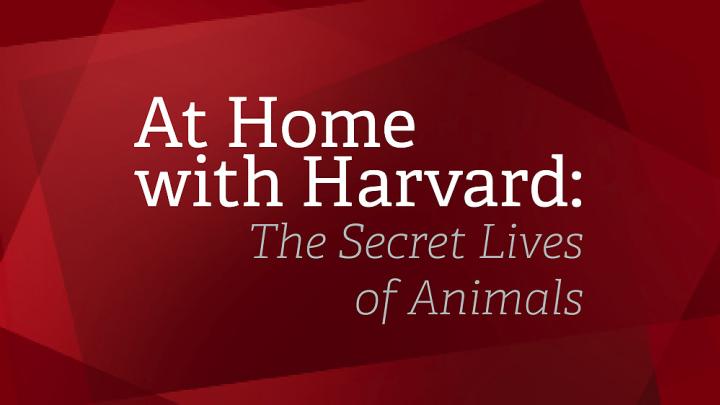This round-up is part of Harvard Magazine’s series “At Home with Harvard,” a guide to what to read, watch, listen to, and do while social distancing. Read the prior pieces, featuring stories about the history of women at Harvard, the climate crisis, the undergraduate experience, and more, here.
From zoology and evolutionary science to animal-rights law to the joys of local wildlife, we love to write about how non-human animals can enrich your understanding of the world. Here is a selection of Harvard Magazine’s favorite animal stories; we hope you’ll enjoy them and feel inspired to go outside and take in spring, where, pandemic or not, baby animals of all species are taking their first steps into the world.
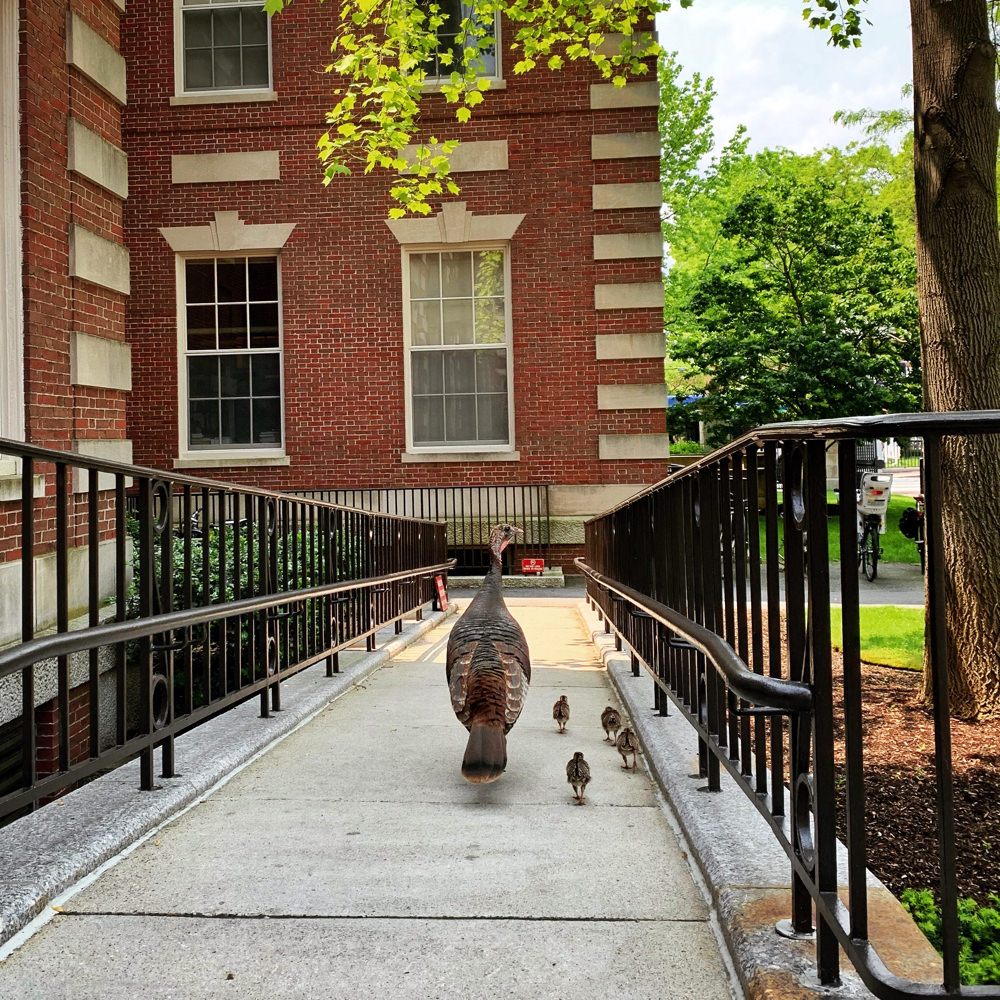
Photograph by Allison Kern/Harvard Magazine
It’s currently baby-bird season, and baby turkeys are among them. I grew up in Ohio, but have lived in Massachusetts for the past seven years; even though I’ve lived in New England for a while, I’m still startled by seeing wild turkeys! This informative article by my colleague, Marina Bolotnikova, “It’s Baby Turkey Season in Cambridge,” helped me learn more about these majestic birds: “Turkeys are nothing to be alarmed by: they have thrived in urban areas ever since they were reintroduced in Massachusetts in the 1970s, after being hunted to extinction by the mid nineteenth century. Today, there are an estimated 30,000 to 35,000 turkeys in the state.” So if you see a momma turkey with her poults, you can stare and take pictures, but don’t interact with them in any harmful way—it’s against the law!
~Kristina DeMichele, Digital Content Strategist
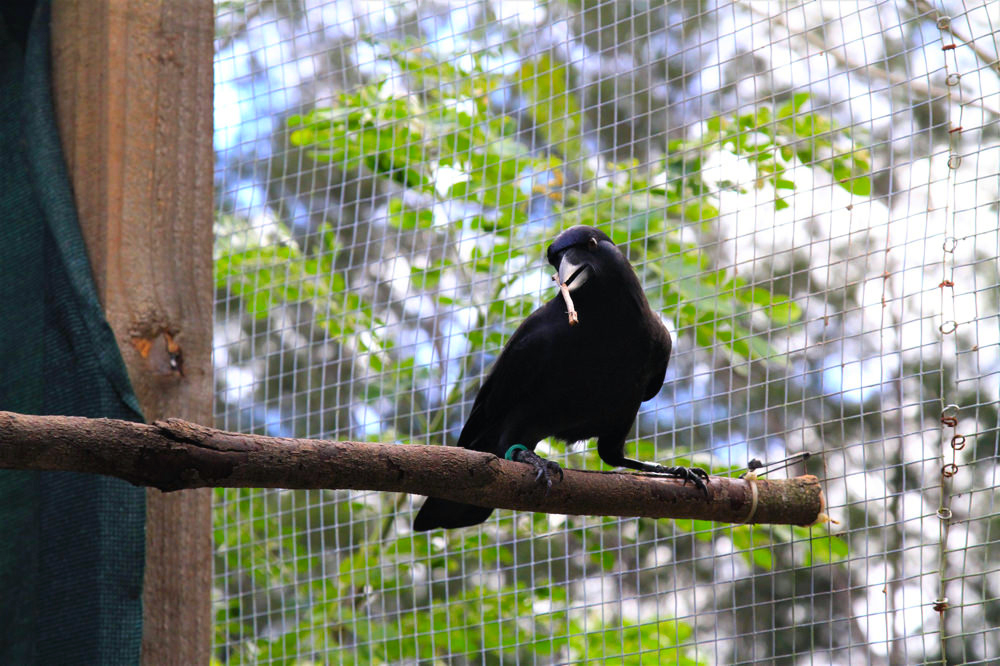
A crow holds a stick tool during its downtime from the experiment.
Photograph by Dakota McCoy
Crows are smart! Though their small brains once led biologists to believe they were incapable of higher cognition, it turns out this was wrong. Their brains are quite dense, and packaged differently than primate brains. This allows crows to create rather complex tools. This lively article, “Crows Know How to Have Fun,” reviews research suggesting that they also like a challenge. Having to use a tool to grab food puts crows in a better mood than grabbing it without a challenge. Just as humans get pleasure from cognitively challenging tasks and games, “crows seem to intrinsically enjoy tool use,” says organismic and evolutionary biology graduate student Dakota McCoy.

Brown anole perched on a branch
Photograph by Oriol Lapiedra
Like humans, lizards vary in appetite for risk. If a predator is around, some will hide, but others will stay out in the open. Whether variations in behavior play a role in natural selection is the subject of some debate. Some scientists think it impedes evolution. If an animal can change its behavior to adapt to a condition (moving into the shade to escape warmer temperatures), it won’t adapt physically to changing environments. Some think it helps. It could lead populations who make risky decisions (a fish venturing onto land) to adapt to a new environment over time. Though I am not qualified to settle this debate, I can recommend “Risk-Taking Lizards,” by associate editor Marina Bolotnikova, about a 2018 study involving groups of lizards dispersed on tiny Bahamian islands.
~Jacob Sweet, Staff Writer/Editor
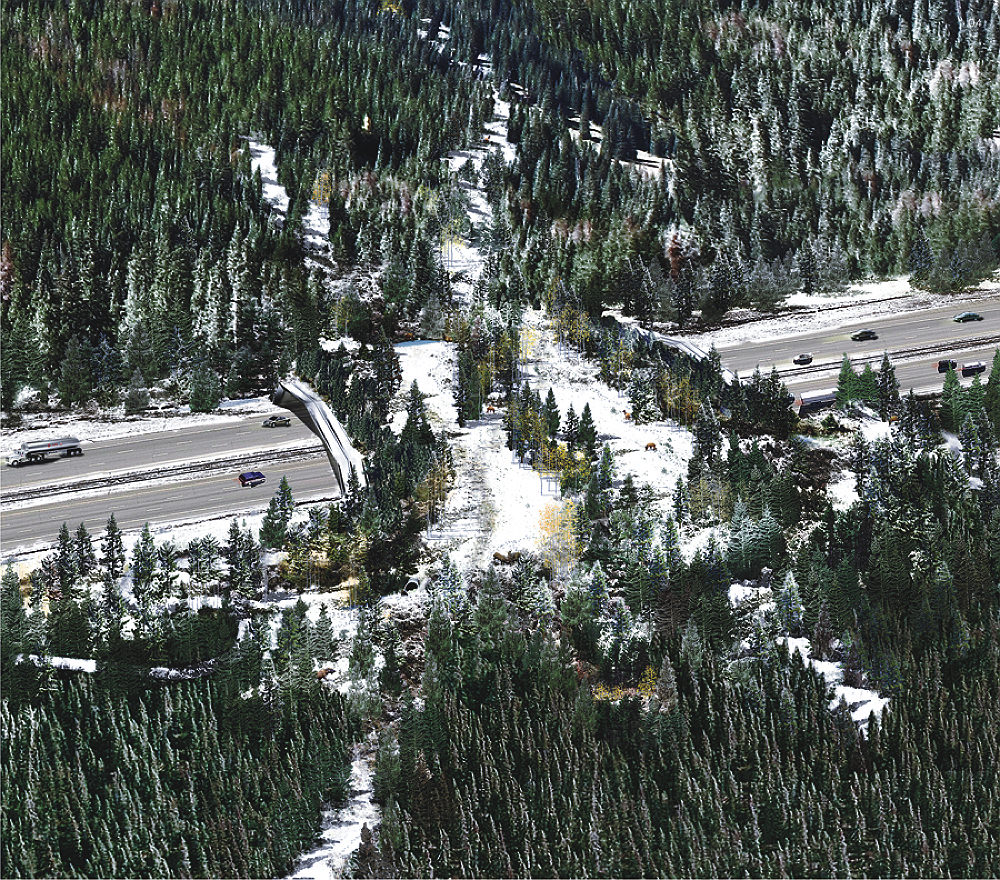
The winning wildlife-crossing design distills multiple habitat types from the surrounding landscape into parallel bands that act as corridors for various animal species. Wide bands provide an open field of view, while narrow forest and shrub bands provide enclosed corridors.
Image courtesy of The ARC International Wildlife Crossing Infrastructure Design Competition/ HNTB and Michael Van Valkenburgh Associates
Across the country, the U.S. highway system carves wildlife habitats into smaller regions. This puts populations of animals that cross busy roadways in search of food and mates—such as bear, lynx, and moose—at risk. To address this problem, which is particularly acute in the West, transportation and wildlife agencies in the U.S. and Canada staged a design competition to create wildlife crossings for the nation’s roadways. The winning design team included the Graduate School of Design’s Michael Van Valkenburgh, Eliot professor in practice in the department of landscape architecture, whose work in urban settings this magazine has previously profiled. The winning design, which was the unanimous choice of the competition’s international jury, incorporates four distinct ribbons of habitat linking one side of the bridge to the other.
~Jonathan Shaw, Managing Editor
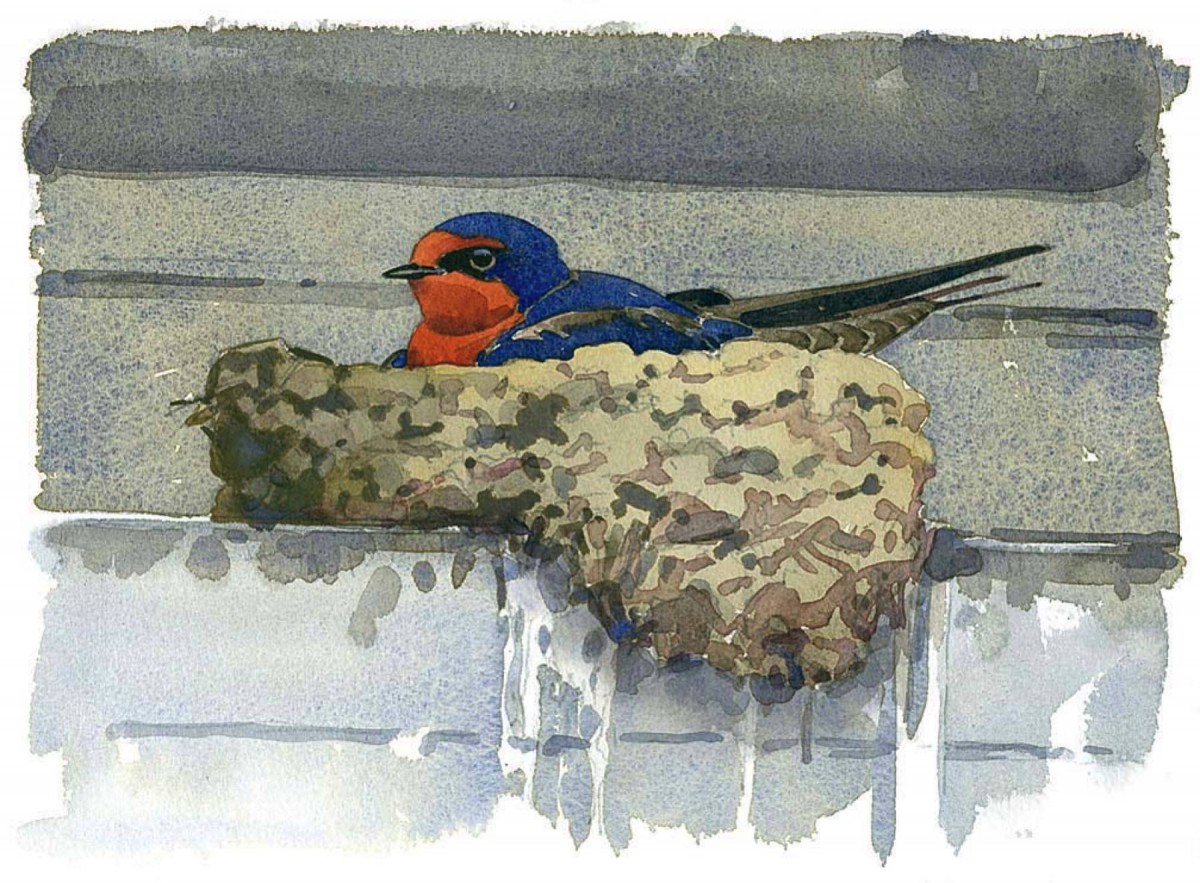
Barry Van Dusen’s barn swallow (nesting at Stone Barn Farm)
Courtesy of Barry Van Dusen
John James Audubon is probably the most famous bird-portraitist, but by no means the only one, and in “Birds In Hand,” my colleague Nell Porter Brown tells the story of an unusual museum in Canton, Massachusetts, dedicated to American artwork inspired by birds. Housed on a 120-acre rural estate that was bequeathed to Mass Audubon in 1989, the museum, in Nell’s description, is charming: “There are thousands of works—from engravings by John James Audubon himself to Pop Art silkscreen prints of a bald eagle and Pine Barrens tree frog (donated by their creator, Andy Warhol) to the exquisite carved decoys, coveted by collectors, of Anthony Elmer Crowell.” The museum is closed for now because of the pandemic, but it’s definitely on my list for whenever things open up again.

Green anole lizard
Photograph by PiccoloNamek/WikiCommons
Green anole lizards have always been a favorite of mine—so plucky and charismatic. They were a fixture of my summers growing up in Virginia and North Carolina, showing up all over the place in our family’s gardens and flower beds. In the winter, you’d see them clinging to windows or tree trunks, moving slowly, waiting for the sun to come out. The intense cold of 2013-14 hit them and other wildlife hard, and in “Extreme-Weather Evolution,” my colleague Marina Bolotnikova describes a kind of study that’s relatively rare now but seems sure to become more common as climate change progresses: the natural selection effects of individual extreme weather events. In this case, on green anoles in Texas and Oklahoma. The study was a combination of luck and curiosity and imagination, and its results have implications for this and other species’ future as weather and climate become more volatile.
~Lydialyle Gibson, Associate Editor
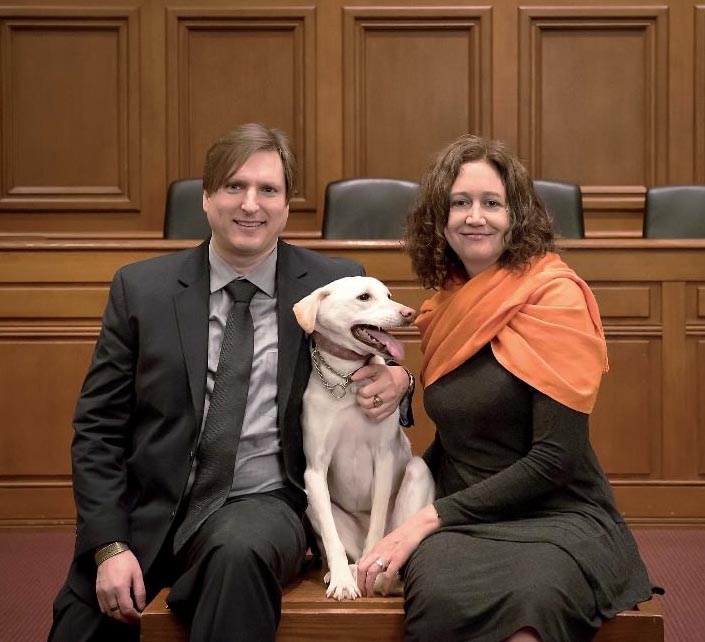
Chris Green and Kristen Stilt in Austin Hall’s Ames courtroom with Lola, Stilt’s rescue dog from Egypt
Photograph by Stu Rosner
“Though treatment of animals has always been an issue, only recently has law begun to take it seriously,” said then-Harvard Law School dean Martha Minow. “For anyone thinking about the purpose of law, the legal treatment of animals forces a confrontation with what law is actually about—‘What are its purposes? What are its limits? Is law only about human beings?’” One way to understand legal history, she explained, is to trace “the ever-expanding circle of law—who’s in and who isn’t.” Animal law is part of the newest expansion of that circle, and “there’s an opportunity now to contribute to the development of law reform in a way that hasn’t always been the case.” These are not the sorts of issues a preeminent law school’s dean might seem to want to address, and yet, with her support, HLS has—as explained in this searching feature on a new program probing the legal definition and limits of animal rights and animal welfare.
~John Rosenberg, Editor
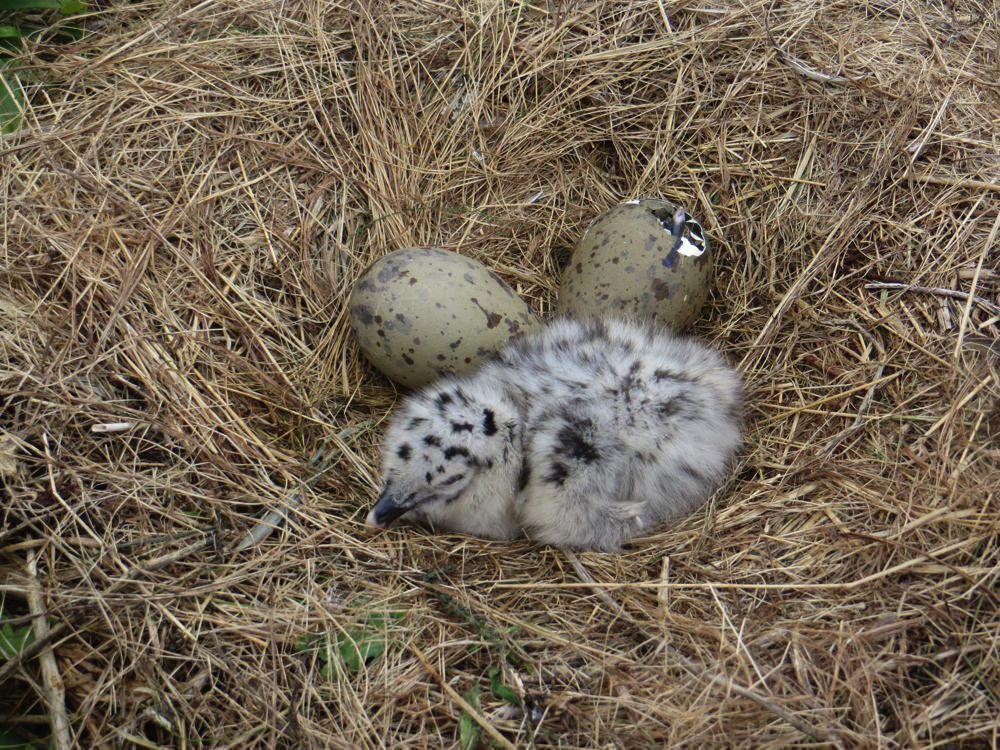
Gull eggs and a recently hatched chick
Photograph by M.C. Stoddard
This isn’t quite an animal story, but this piece about the evolution of different birds’ egg shapes was a delight to report and write. Keep it in mind as you spot bird eggs outside!
~Marina Bolotnikova, Associate Editor
More from “At Home with Harvard”
- Spring Blooms: Your guide to accessing the Arnold Arboretum as the seasons turn in Boston
- Harvard in the Movies: Our favorite stories about Harvardians on screen
- The Literary Life: Our best stories about the practice and study of literature
- Night at the Museum: Our coverage of Harvard’s rich museums and collections
- Nature Walks: Walking, running, and biking in Greater Boston’s green spaces, even while social distancing
- Supporting Local Businesses: Our extensive coverage of local restaurants and retailers, and how you can support them during this time of crisis
- Medical Breakthroughs: Our best stories going deep into the ideas and personalities that will shape the medical care of tomorrow
- Rewriting History: From race and colonization to genetics and paleohistory, our favorite stories about the people reshaping the study of history
- The Climate Crisis: Highlights from our wide-ranging coverage of the environment
- Crimson Sports Illustrated: With 2020 winter sports ending early and the spring collegiate season wiped out almost entirely, we look back at Crimson highlights from past years.
- The Real History of Women at Harvard: Stories covering the admission of women, the Harvard-Radcliffe merger, the rise of women in the faculty ranks, Harvard’s first woman president, and more
- The Undergraduate: Our favorite student essays on the undergraduate experience
